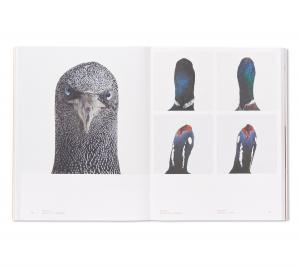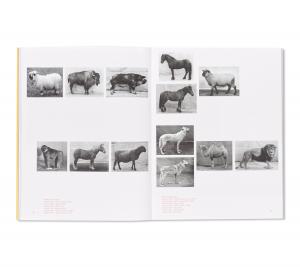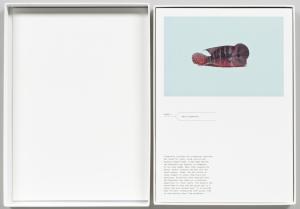Shinya Arimoto’s third publication with Tokyo-based publisher Zen Foto Gallery is a deep dive into the world of bugs, critters and insects. Shot between 2010 and 2019, Arimoto travelled to the mountainous areas of Okutama and Hinohara – far away from the city but still part of Tokyo Prefecture – to capture moths, mantises, worms, spiders, snakes, frogs and other animals up close. Brilliantly, Arimoto intersperses photographs of abandoned architecture as traces of past human activity, widening the scope of his series. For Arimoto, the city of Tokyo and these mountainous areas belong to different sides of the same coin, and insects – beings that clearly belong to a different realm of nature than us – transcend the boundaries between these sides, free to move back and forth between the two. Arimoto captured another world within Tokyo, dominated by the most successful creatives on the planet, unimpressed by the ongoing sprawl of the asphalt and cement megalopolis.
-
-

- Tokyo Debugger
- Shinya Arimoto
- Zen Foto Gallery
- 2020
→more -
-
-

- Mariposas Nocturnas: Moths of Central and South America, A Study in Beauty and Diversity
- Emmet Gowin
- Princeton University Press
- 2017
American photographer Emmet Gowin (b. 1941) is best known for his portraits of his wife, Edith, and their family, as well as for his images documenting the impact of human activity upon landscapes around the world. For the past fifteen years, he has been engaged in an equally profound project on a different scale, capturing the exquisite beauty of more than one thousand species of nocturnal moths in Bolivia, Brazil, Ecuador, French Guiana, and Panama.
These stunning color portraits present the insects—many of which may never have been photographed as living specimens before, and some of which may not be seen again—arrayed in typologies of twenty-five per sheet. The moths are photographed alive, in natural positions and postures, and set against a variety of backgrounds taken from the natural world and images from art history.
Throughout Gowin’s distinguished career, his work has addressed urgent concerns. The arresting images of Mariposas Nocturnas extend this reach, as Gowin fosters awareness for a part of nature that is generally left unobserved and calls for a greater awareness of the biodiversity and value of the tropics as a universally shared natural treasure. An essay by Gowin provides a fascinating personal history of his work with biologists and introduces both the photographic and philosophical processes behind this extraordinary project.→more -
-
-

- Die Anthropomorpha: Tiere im Krieg
- Malin Gewinner
- Matthes & Seitz Berlin
- 2017
Fallschirmspringende Hunde, ferngesteuerte Haie, Raketen, die von Tauben gelenkt werden, Katzen mit implantierten Abhörgeräten : In diesem Buch geht es um Tiere, die der Mensch zu Kriegsteilnehmern gemacht hat. Die militärische Nutzung von Tieren spielt seit Anbeginn der Kriegsgeschichte eine entscheidende Rolle. Tiere sind ständige Wegbegleiter, jedoch keineswegs ebenbürtige Partner der Menschen. 32 erstaunliche, skurrile und bizarre Tiersoldaten dieses Buches zeigen, dass der Mensch keine Grenzen kennt, wenn es darum geht, sich gegenüber dem Feind einen Vorteil zu verschaffen. Woher kommt die Selbstsicherheit, mit der der Mensch sich die Fähigkeiten der Tiere zunutze macht ? Welche Konsequenzen hat das für Mensch und Tier, und wie und warum gerät der Vormachtsglaube der Menschen gerade zu Kriegszeiten ins Wanken?
→more -
-
-

- Animals That Saw Me: Volume Two
- Ed Panar
- The Ice Plant
- 2016
Animals That Saw Me: Volume Two pairs a new collection of photographs from the observational wanderings of Ed Panar with an original essay on “being seen” by speculative realist philosopher Timothy Morton. Extending the project Panar began in 2011 with Animals That Saw Me: Volume One, this ‘sequel’ draws from recent work and newly discovered gems from his vast back catalogue to depict a series of brief, shared encounters with various (non-human) species — mammal, reptile, bird, insect — as they seem to behold the (human) photographer. Edited for the viewer’s maximum delight, the pictures embody a whimsical concept with surprisingly complex ramifications under the surface. Why do we distinguish between “us” and “them,” and what exists in the space between these distinctions? What does it mean to make “eye contact” with another species? What does the presence of a camera add to this phenomenon? Channeling the thoughtful humor, wonder and peculiar engagement with the world that made Panar’s first volume an instant hit, this volume revisits and digs deeper into the question: “Why do we assume that it’s only us who does the looking?”
→more -
-
-

- Animality
- Jens Hoffmann
- Marian Goodman Gallery
- 2017
Our relationship with animals is fraught and contradictory: we simultaneously mythologize, venerate, sacrifice, and exploit those who are not of our species. This paradox suggests that our connection with animals might be more complicated, and far richer, than commonly thought, and that the distinction between human and animal is not at all clear-cut. By laying down a novel artistic and theoretical framework, Animality, devised by Jens Hoffmann in conjunction with Marian Goodman Gallery, looks to examine this complex relationship. Written to accompany an exhibition of the same name, it includes more than seventy participants, mostly from the world of art, but also covering film, literature, philosophy, and science.
→more -
-
-

- Animal Imago
- Lucia Nimcova
- Sittcomm.sk
- 2013
Animal Imago is Nimcova's fourth publication, this time around, departing from social and documentary topics, finding herself publishing a book for kids of all ages. The book is dealing with our relationship with animals and nature around us. "In essence, it speaks to the idea that the reality of the world around us is never a given, it is something we have to create".
→more -
-
-

- Animal Books for Jaap Zeno Anna Julian Luca
- Lous Martens
- Roma Publications
- 2017
Lous Martens about the book: "Seventeen years ago our grandson Jaap was born. That was the start of an animal book for Jaap. I used a dummy for the OASE journal of architecture and loosely pasted in pictures of animals that I had clipped from newspapers and magazines about art, literature and science. Plus stamps and photos from advertising brochures. Then Zeno was born and the same thing happened: an animal book for Zeno. Now I was working on two books at once. Then came Anna. Julian. Luca. At this point, there were five books-in-the-making on the table. And none of those five are finished yet. The children, as well as myself, enjoy seeing the small, ever-evolving changes. The additions. These books were never intended for the outside world where I had found all the pictures. Never intended to be published. Now they lie here, grouped into one big book, because others have convinced me it's what they deserve."
→more -
-
-

- A Guide to the Flora and Fauna of the World
- Robert Zhao Renhui
- Steidl
- 2018
To what extent can we trust photography and science? Robert Zhao Renhui explores these questions in A Guide to the Flora and Fauna of the World, which appears to be an authentic catalogue of plants and animals but is in fact entirely fictitious.
Renhui’s guide ostensibly “documents” 55 different animals, plants and environments that have been manipulated by man but do not appear to be, and examines the myriad ways in which humans are altering nature. Here are curious creatures that have evolved in often unexpected ways to cope with our changing world, including rhinoceroses with barely visible horns and monkeys dependent on food handed out by humans. Other organisms in the series are the products of human intervention, mutations engineered to serve various purposes from scientific research to the desire for ornamentation, such as man-made gelatin grapes, genetically modified tomatoes and “unbreakable” eggs.
All living things constantly adapt to the various pressures they face including predators, pollution and environmental change. Yet the human species has undeniably emerged as the main perpetrator of the dangers that threaten the survival of other life forms. A Guide to the Flora and Fauna of the World reminds us of this fact, and above all to retain a critical, cautious and ironic attitude to the “real.”
→more -











